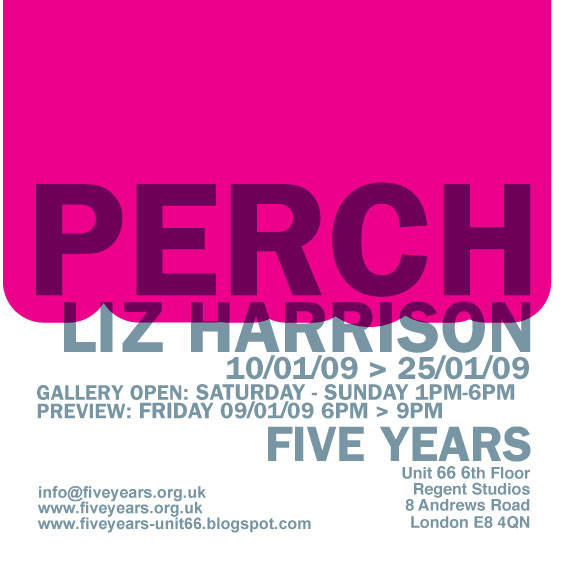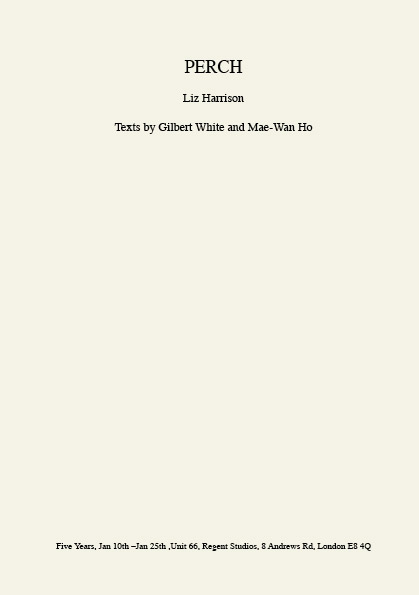
//// //// //// //// ////
//// //// ////
PERCH
LIZ HARRISON





Walking into Liz Harrison’s installation Perch at Five Years you could be forgiven for mistaking it for a pastoral scene. Despite its leafy tree and melodious birdsong it is not a Fête champêtre transposed into light-industrial Hackney. The birds we hear are cockney sparrows - as urban as foxes. Once ubiquitous in London, we didn’t notice them until they vanished. In the city they used to enliven the spaces between, animating hedges, borders, backyards and lunch-breaks.
The installation at Five Years consists of a tree, a projection and two monitors.
This tree is plumbed into neat copper pipes anchored by a concrete cube – homemade hydroponics. Its limbs are surely dead but sprout hopeful plastic foliage. The sparrows are spectral, projected into the branches and beyond onto the wall, where they twitter in a kind of vaseline-lens supernature. It is a post-dated monument, where the present looks like the future looking back, a form of mournful magic in the best tradition of utopian displacement.
The two monitors act as more than footnotes, they underwrite the tree. The first video shows a hand writing a letter with a dip pen, the second documents an article being written on a typewriter; the page on screen filling gradually with text from the bottom up. These are old technologies of transcription, drowned world archiving. What is at stake here is how things are registered in our lives. How we image, how we mark.
The letter we see being rewritten is from Gilbert White’s Natural History of Selbourne, first published in 1789 and in print ever since. White’s letters record his close observations of the world around him and his insights into the relationships of living things. He distinguishes birds by their call, finds that owls sing in different keys in different woods. The more he looks the more he sees. He writes with pleasure. Both naturalist and poet, White lived in an age when the layers of the modern were being laid down gradually; the phenomenal world noted and ordered through taxonomy and categorisation. He was a contemporary of Linnaeus and Kant, the generation immediately before Darwin. His words conjure images of a land teeming with life and diversity, a rude magnificence, a cacophony of birdsong. Our world now seems lifeless by comparison.
The second text being tapped out mercilessly is a googled article. It speculates a correlation between phone mast radiation and the decline of the sparrow. Certainly the mobile phone mast marks a sense of locality, its electromagnetic fields are patch-worked throughout the city. Very few areas are without network coverage. Our burgeoning communications technology means that the idea of periphery has all but disappeared. The space between has gone.
Metaphorically at least the space of art practice can be a ‘space between’; a space where objects and images may be sensitised or brought into conjunction to produce affect. Liz Harrison’s Perch operates in this space, it works on an axis of longing and loss. It also reminds us that if there is hope amidst the brushed steel surfaces and perspex mirrors of late capitalism, it is that the city is never quite hermetic. Given the chance there’s usually something slithering in the gaps or fluttering for crumbs.
X
X
X
X
X
X
X
X
------------------------------------.------------------------------------.-------------------------Louisa Minkin
Perch is a new video and sculptural installation by Liz Harrison, and concerns reflections on vanishing birds and ornithological observations.
This work is a site specific response to the space at Five Years, housed within an industrial unit, ‘perched’, the last cube along the 6th floor corridor, on the edge of the building; a purely functional building devoid of any sense of place or relationship with the natural environment. It invokes feelings of anonymity, void, exclusion. This arid space catalysed a visual response invoking observations on nature from past, romantic viewpoints and present day personal observations on the natural world, and its demise, a theatre imported. The void is re-presented by the simply staged artificiality of a natural habitat. The format and methodologies for this installation reveal conflicts of realities, the ordinary and the mundane/ the poetic, the imaginary and the idealistic.
Central to the installation is the chance filming of sparrows, once ubiquitous in our cities, which has stimulated the ideas and form of this video installation. It reveals an illusion that evokes feelings of not only sentiment but also disquiet. The film is both familiar and comic and is staged as a fictional tableau, but invokes an inevitable sense of unease about our expanding technological environment. Our desire is for things always to remain the same, and to believe in the ‘bird’ or the ‘sparrow’ chirruping away and for it to be a given sentiment.
Location is imagined and seen as a microcosm, past or present. It questions our illusion of the stability of life, bringing together the unpredictable elements that will always exist in delicate balance. History is re-animated into the present, with a juxtaposition of ideas and notions. The writings of the 18th century naturalist Gilbert White, the Victorian extravaganzas of imported tropical habitats in the late 19th century, to the mobile communication systems that have escalated from the 20th to 21th century have all inspired and informed this work.
--
-
-
-
-
-
-
